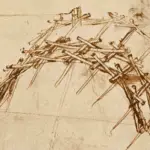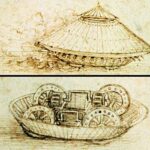Leonardo da Vinci Catapult is an intriguing invention. Its design stands out because it combines artistic creativity with scientific precision. The catapult featured a leaf spring system and a rotating drum mechanism, improving the power and efficiency of traditional catapults.
Leonardo da Vinci‘s innovative approach to warfare and defense fascinates those who are curious about the future applications and impacts of his catapult.
His designs influenced military technology and contributed to the broader engineering field. The Leonardo da Vinci Catapult allows visitors to explore these revolutionary concepts more deeply.
This invention is a testament to da Vinci’s forward-thinking mindset, reflecting his view of the relationship between form and function.
Studying his improvements to this device reveals the extensive knowledge and creativity he applied to his work.
Historical Context of Leonardo da Vinci’s Inventions
Leonardo da Vinci, a prominent figure of the Renaissance, contributed significantly to science and engineering. His inventions, such as the Leonardo da Vinci Catapult, reflect the era’s interest in military advancements and innovation.
The Renaissance and Militaristic Inventions
Europe experienced a surge in cultural, scientific, and technological progress during the Renaissance. This period was marked by a renewed interest in classical knowledge and an eagerness to innovate. Military technology saw remarkable advancements during this time.
The ancient Greek catapults had been used for centuries, but their designs evolved. Leonardo da Vinci, intrigued by these ancient mechanical devices, developed his version.
The Leonardo da Vinci Catapult improved previous designs by incorporating innovative features to increase its power and range.
Military engineering was critical during the Renaissance, as conflicts and territorial expansions were rampant. Da Vinci’s work stood out because he combined his artistic skills with practical engineering, resulting in sophisticated designs ahead of his time.
Extensively studied catapult models provide insight into his genius and the period’s technological capabilities.
Leonardo’s Role as an Inventor and Engineer
Leonardo da Vinci’s role extended beyond that of an artist. He was also a visionary engineer and inventor. He applied his understanding of mechanics and physics to create artistic and functional designs.
Da Vinci’s inventive genius is evident in designs like the armored vehicle and the Leonardo da Vinci Catapult. Though many of his inventions were not built during his lifetime, they influenced later developments in engineering. Leonardo’s notebooks reveal detailed sketches and ideas that often blended creativity with scientific exploration.
His ability to envision machines like the catapult, which he innovatively designed to suit the needs of his time, showcases his impact. Leonardo’s legacy as an engineer has left an indelible mark on technological advancements, inspiring generations of inventors.
Design and Mechanics of the Catapult
Leonardo da Vinci’s catapult showcases his ingenuity in reimagining medieval catapult design with improved efficiency and power. By studying existing mechanics, he aimed to enhance projectile launching by exploring innovative materials and mechanisms.
Conceptual Drawings and Notes
Leonardo da Vinci created detailed sketches and notes demonstrating his visionary approach to catapult design. Although his catapult was not an entirely new invention, he sought to refine existing concepts through thoughtful adjustments. One of his designs included a double-leaf spring mechanism, allowing increased tension and power.
His sketches were precision-oriented, considering force vectors and projectile trajectories. Careful calculations ensured stability and balance, which is vital for an effective launch. Although his designs were not built during his lifetime, they offer insight into his mechanical brilliance and forward-thinking approach.
Mechanical Principles and Operation
Leonardo da Vinci’s catapult’s core mechanics revolved around tension and torque-enhancing launching force. Unlike traditional torsion-based catapults, it utilized a spring leaf mechanism. This adjustment allowed for more controlled and powerful launches, increasing the range and impact of projectiles.
Leonardo also focused on improving the loading and firing mechanism. His designs aimed to simplify the process, making it more efficient for potential wartime use.
His understanding of torque and tension motivated this enhancement, ensuring each component worked symmetrically. As a result, da Vinci’s catapult demonstrated artistic prowess and an advanced grasp of engineering principles.
Construction and Materials
Leonardo da Vinci’s catapult showcases the innovative use of materials and construction techniques. Its design reflects a blend of wood and rope preferences, and its unique approach to tension and counterweight systems enhanced its efficiency as a war machine.
Wood and Rope Preferences
Leonardo da Vinci’s catapult relied on carefully selected wood and rope, which were vital for its functionality. Hardwoods like oak were preferred for their durability and strength, which is essential for withstanding the stress of launching projectiles. Softwoods, despite being lighter, were less common in such applications.
Ropes made from natural fibers like hemp were flexible and strong. Hemp’s elasticity was crucial for efficiently absorbing and releasing energy during the firing process. The combination of hardwood for structural components and hemp for tension elements ensured a balance between strength and flexibility, helping to maximize the power and range of the projectiles.
Tension and Counterweight Systems
Leonardo da Vinci’s approach to tension and counterweight systems in his catapult design was distinctive. These mechanisms were crucial for the catapult’s ability to launch projectiles.
By optimizing the tension in the ropes and employing counterweights, the da Vinci catapult could achieve significant force and distance.
Tension was carefully adjusted by winding ropes, a method derived from earlier torsion-based catapults, such as the ancient Greek models. This tension-powered mechanism allowed controlled and precise releases, while counterweights provided the necessary balance to maintain stability during operation.
This integrated system of tension and counterweights exemplifies Leonardo’s ingenuity. He melded ancient catapult principles with his inventive enhancements, and this thoughtfulness in design and construction enabled his catapult to perform effectively as a formidable weapon at the time.
Leonardo da Vinci’s Influence on Warfare
Leonardo da Vinci’s innovative designs transformed the landscape of military technology. His work on war machinery, such as the da Vinci catapult, provided fresh insights into the capabilities and mechanisms of siege engines.
Comparison to Contemporary Siege Engines
Impact on Military Engineering
Leonardo da Vinci’s contributions went beyond weaponry. He influenced the broader field of military engineering. His sketches, which include detailed mechanisms and structural designs, inspired future generations to explore new engineering possibilities.
The da Vinci catapult showcased how art and science could converge to improve military technology. His emphasis on precision and efficiency paved the way for modern engineering strategies used in warfare.
By focusing on practicality alongside creativity, da Vinci’s inventions encouraged a shift from brute force to more calculated and efficient methods of attack, altering the course of military strategy development. His work on siege engines remains a testament to his profound impact on military design and engineering.
Exploring the Evolution of Catapults Throughout History
Mangonel Catapult – The First Known Catapults
The question of who invented the catapult takes us back to the ancient world. The first known catapults were developed in ancient Greece in the 4th century BC, specifically by a Syracuse engineer named Dionysius the Elder.
Unlike the da Vinci catapult, these early devices relied on torsion power from twisted ropes or sinew rather than tension or counterweights. This type of catapult, also known as a mangonel catapult, used the stored energy in the twisted ropes to hurl projectiles toward the enemy.
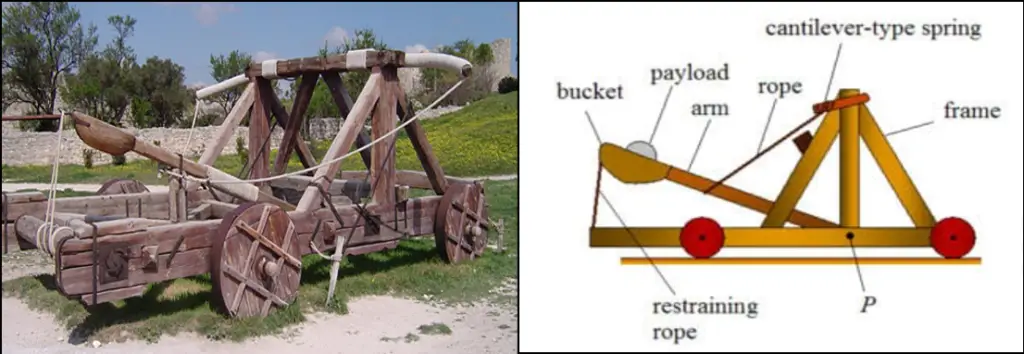
Mangonel Catapult
Ballista Catapult
As centuries passed, catapult design blueprints saw significant changes. Greek and Roman engineers refined and diversified catapult designs, introducing new mechanisms like the ballista and onager.
It’s fascinating to compare these classical designs with the more sophisticated da Vinci catapult, a testament to the evolution of engineering over the millennia.
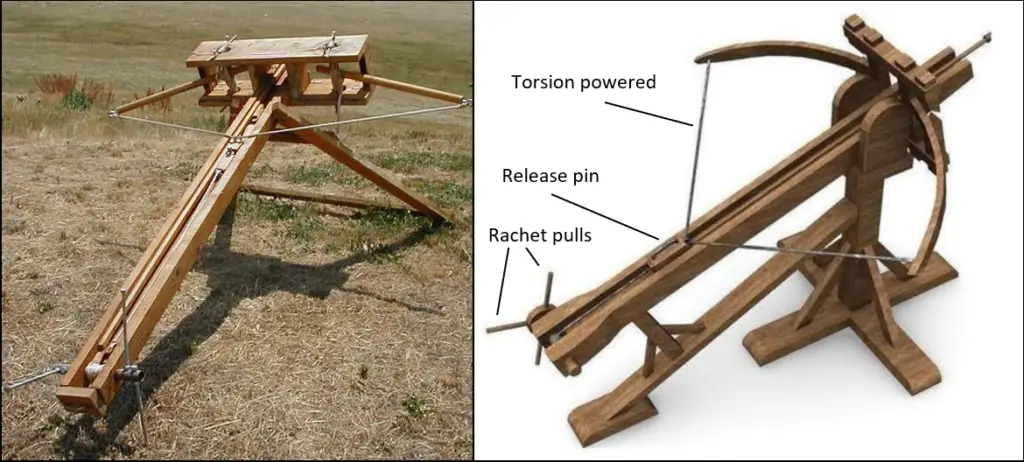
Ballista Catapult
In East Asia, the Mongolians advanced catapult technology by creating the Mongolian catapult, or Hwacha. This innovation could fire multiple projectiles at once, a stark contrast to the single-projectile designs common in the West.
Trebuchet Catapult
Catapult technology saw another shift during the Middle Ages. The most prominent type of catapult used during this period was the trebuchet. This siege weapon used a counterweight mechanism, unlike the tension-based design of the da Vinci catapult.
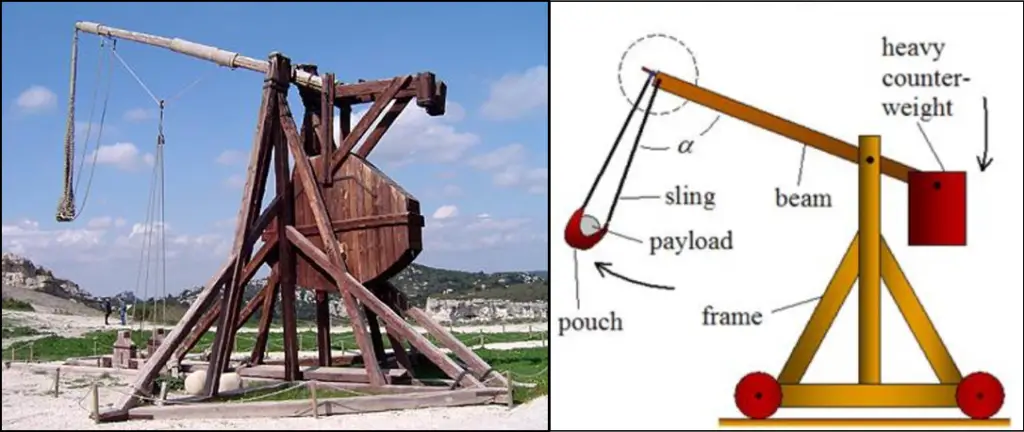
Trebuchet Catapult
Trebuchets were the apex of medieval siege technology, capable of hurling large projectiles at great distances. The introduction of counterweight technology marked a significant departure from the ancient torsion catapult design, leading to more powerful and efficient siege engines.
Despite the differences in design and the centuries that separate them, the trebuchet and the Leonardo da Vinci catapult share a common purpose: to use mechanical advantage to achieve power and precision beyond human capabilities.
Facts and Curiosities
5 Fun Facts About Catapults
Here are five fun facts about catapults that might surprise you:
- The Greek engineer Dionysius, who invented the catapult, first developed it in 399 BC.
- ‘catapult’ comes from the Greek words ‘kata,’ meaning ‘downwards,’ and ‘paleo,’ meaning ‘to toss.’
- During the Middle Ages, some catapults launched diseased animals or corpses over castle walls to spread disease among the enemy. It is a disturbing yet fascinating example of early biological warfare.
- The most enormous catapult ever recorded in history was built by Edward I of England during the siege of Stirling Castle in 1304. It was named ‘Warwolf‘.
- Today, what a catapult is used for varies from launching aircraft from aircraft carriers and pitching machines in baseball to launching lifeboats.
Da Vinci’s Catapult: 4 Lesser-Known Facts
There are 4 Leonardo da Vinci catapult facts that might not be commonly known:
- Leonardo da Vinci’s catapult design was more sophisticated and powerful than those used at the time. It was designed for accuracy, not just power.
- Da Vinci’s design used a spring-like tension mechanism, unlike the torsion-based catapults of the ancient world.
- There’s no record that da Vinci’s design was ever built during his lifetime. It existed only as sketches in his notebook until modern enthusiasts brought it to life.
- In Italian, the word ‘catapulta’ is sometimes referred to as Leonardo da Vinci catapulta.
Modern-Day Uses of Catapults
In contrast to their original role as siege engines, what is a catapult used for in modern times is remarkably diverse. The physics principles that catapults employ have found applications in various modern technologies:
- The aviation industry catapults to launch planes from aircraft carriers, enabling them to get airborne quickly.
- The entertainment industry uses various forms of catapults, from amusement park rides to film and stage effects.
- Sports equipment like pitching machines in baseball employ a catapult mechanism.

Aircraft Catapult in Aircraft Carrier
Modern Replications and Educational Projects
Modern efforts to recreate Leonardo da Vinci’s catapult bridge the past and the present. These reconstructions offer practical insights into historical siege technologies and engaging educational experiences for learners.
Reconstruction Attempts
Enthusiasts and historians today are captivated by the task of bringing da Vinci’s catapult to life. They aim to precisely replicate da Vinci’s intricate designs using advanced techniques such as 3D printing and laser cutting sites. Instructables detail steps to construct these models, making them accessible to hobbyists and educators.
These projects highlight da Vinci’s work’s elegance while showcasing improvements in design and function over traditional catapult weapon systems. These reconstructions show a clear link between ancient engineering concepts and modern manufacturing capabilities.
Learning Tools in Science and History
Da Vinci catapult replicas serve as valuable tools in education. They bring to life the history of catapults, connecting students with ancient technologies and the evolution of military strategies.
Schools and museums often use these models to teach physics and engineering principles. Through hands-on interaction, tension, force, and trajectory become tangible.
For children and students, working with these replicas fosters curiosity. Educational resources like those found on Teaching Expertise provide activities that nurture creative thinking, marrying historical context with scientific understanding. This makes learning about the catapult’s ancient Greek origins and their application in warfare entertaining and informative.
Final Thoughts
Leonardo da Vinci’s catapult is a testament to his endless curiosity and genius. His variations on the traditional catapult design showed his willingness to rethink and improve upon existing technologies.
These improvements highlighted his interest in mechanics and physics, which were ahead of his time.
Leonardo explored different concepts, like using leaf springs to enhance throwing power.
These sketches demonstrated his understanding of torque and tension forces, paving the way for more dynamic catapult designs.
Though da Vinci’s catapult designs were not widely adopted during his lifetime, they contributed to technological progress and revealed his innovative spirit.
This aspect of his work mirrors his approach to numerous inventions, where creativity met science.
Key Takeaways:
- Leonardo da Vinci’s catapult was not just functional but displayed an innovative application of mechanical principles.
- His relentless pursuit of improvement is evident in his approach to the design of the catapult.
Leonardo’s fusion of art and science continues to inspire modern engineering and design, offering insights that remain relevant today.
Frequently Asked Questions
Catapults have fascinated people for centuries, from ancient war machines to innovative designs by geniuses like Leonardo da Vinci.
These devices illustrate the evolution of engineering, highlighting various types and their historical significance.
Who invented the catapult?
The ancient Greeks initially invented the catapult, specifically by a Syracuse engineer named Dionysius the Elder. They developed it in the Fourth Century BCE to enhance their siege warfare techniques.
When was the catapult invented?
The first known catapults were invented around 399 BCE. They revolutionized how armies conducted sieges during battles.
How does a catapult work?
A catapult stores potential energy in a tension arm or through rope twisting.
This energy propels a projectile across long distances with great force when released.
What year was the catapult invented?
The Greeks are credited with inventing the catapult around 399 BCE. This invention provided a major advantage in warfare at the time.
When was the mangonel catapult invented?
The mangonel catapult was developed in the early Middle Ages, around the 6th century. It was designed to use torsion and tension to produce maximum force.
When was the trebuchet catapult invented?
The trebuchet, which appeared in the 12th century, is considered one of the most potent medieval siege engines. It used a counterweight system to hurl projectiles.
When was the onager catapult invented?
Another Roman innovation, the onager, was developed around the 4th century CE. Its unique mechanism distinguished it from prior catapults.
When was the aircraft carrier catapult invented?
The aircraft carrier catapult, introduced in the early 1900s, was a 20th-century invention. It launched aircraft from naval ships using steam or electromagnetic systems.
When was the torsion catapult invented?
The Greeks first used torsion catapults in the 4th century BCE. They utilized twisted cords to generate powerful launching forces.
How many types of catapults were invented?
There are five main types of catapults. These are ballista, mangonel, onager, trebuchet, and torsion catapults. Each type demonstrates unique engineering approaches and uses throughout history.
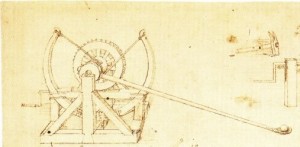
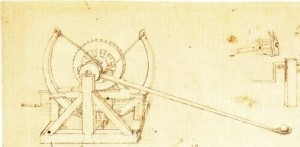
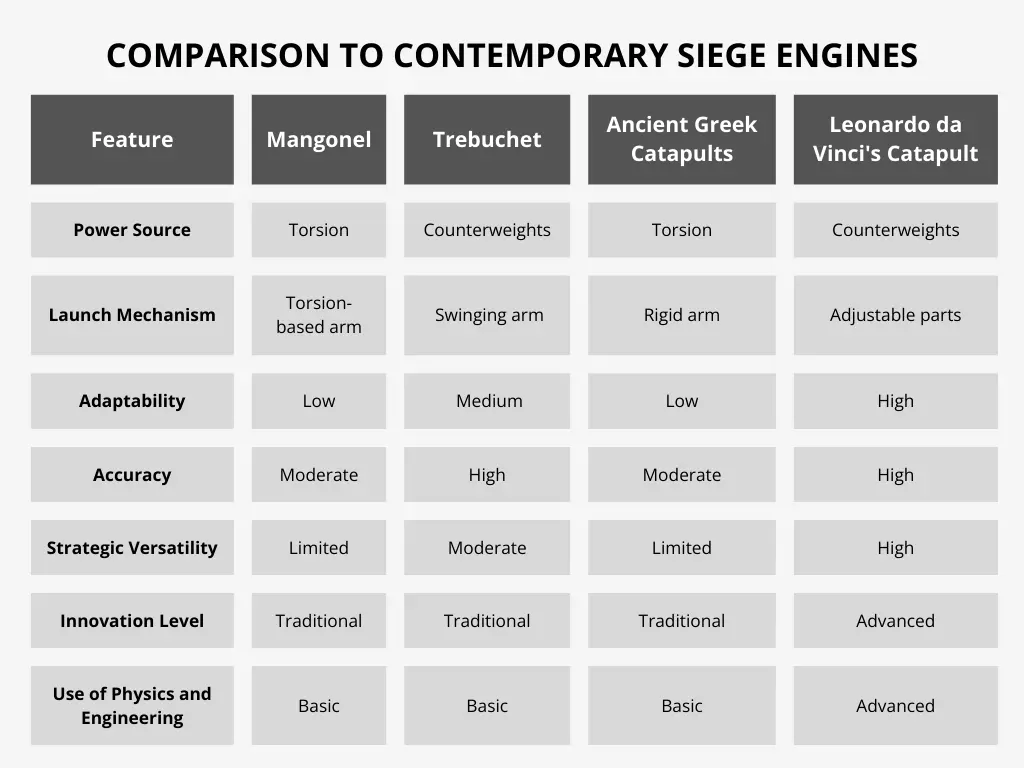
 I’m Leonardo Bianchi, the mind behind Leonardo da Vinci's Inventions. Thanks for visiting.
I’m Leonardo Bianchi, the mind behind Leonardo da Vinci's Inventions. Thanks for visiting. 